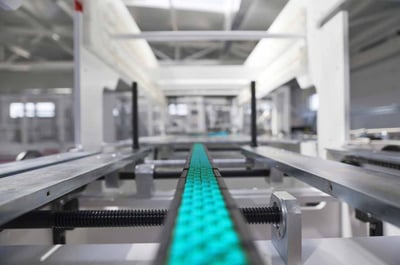What Type Of Shrink Tunnel Conveyor Is Best For My Products?
If you buy shrink packaging machinery or upgrade older equipment, your mind probably goes to one of two places. Shrink tunnels or sealers.
Those are the two pieces of shrink packaging machinery that come to mind for most buyers. This is a common starting point when beginning the buying process for shrink packaging machinery. But, there is another important element to consider, conveyors.
As for which type of conveyor is right for your packaging line, well, that all depends on various factors, the size, weight, and shape of your products will all play a part in determining this.
The Industrial Packaging crew has been working with shrink packaging machinery for generations. Along the way, we have learned a lot about shrink machinery. And conveyors are no exception to the rule.
This article will explore the different types of conveyors currently available. We will discuss the applications for this type of packaging equipment.

Plastic Belt Conveyors
Plastic belt conveyors move products through a packaging line. They move your products from one type of machinery to another.
Belts (of which there are various kinds) are attached to the track. The track is powered by a motor. When the conveyor is turned on, it will move your items from one area to the next.
Conveyors with plastic belts have small interlocked portions of plastic. They can bend as they move in a loop around the track.
The shape of the track and the conveyor's length is dictated by the applications the conveyor is used for. Plastic conveyors can be custom-made to move in various directions. They can move up or down and in as many configurations as needed.
Stainless Steel Belt Conveyors
Stainless steel belt conveyors are made for applications that need regular wash downs. With this type of conveyor, the belt is made from stainless steel rather than plastic. This type of machine features many components that are made from stainless steel such as gears, wash-down motors, frames, and rollers.
Typical applications for stainless steel belt conveyors include packaging for food production. Also, liquids and drugs are often packaged with this type of conveyor.
Stainless steel conveyor belts last much longer than their plastic counterparts. But, they are more expensive to buy, maintain, and upgrade.
Should you use a stainless steel conveyor?
That depends on the types of packaging applications you are implementing. Some types of products require stainless steel conveyors, for example, corrosives.
Need Help Choosing The Right Equipment?
Roller Conveyors
Instead of belts, roller conveyors use rollers that sit on a collection of shafts on a frame. The rollers spin as the product moves across them. This results in the products moving from one end of the conveyor to another.
They are used for moving items with uneven surfaces with ease. Products used on roller conveyors include buckets, barrels, bags, and other items. Products roll forward or backward to move along the conveyor.
Roller conveyors have higher weight limits than other common conveyor alternatives. Roller conveyors are utilized in warehousing applications, packaging, and distribution centers. For example, Amazon often uses them to fulfill orders.
Live Roller Conveyors
Live roller conveyors use powered rollers to push products through your packaging line. They are used in many industries for various types of packaging processes and are a durable form of conveyor system.
Live roller conveyors are commonly used in beverage distribution. They are often utilized to transport medium and larger sized products.
Solid Belt Conveyors
General-use solid belts are the most common type of conveyor belts. These types of belts are made from materials including rubber, polyester, and fabric. For example, mining operations often use rubber belts on their conveyors. This is done to manage materials such as coal and ore. Department stores will often use solid belt conveyors for their products as well.
Shrink Film Considerations For Conveyors
Consult with your packaging vendor before purchasing a conveyor of any kind. Depending on which type of shrink film you are using, you may be limited to certain types of conveyors. This is due to the formulation of shrink film that you are employing.
When using polyethylene films, the drying may take longer and fans are employed to speed up this process. But, polyethylene may stick during the drying process. If the polyethylene is not thoroughly dried before it is run on a live roller, it may gum up the rollers and cause lots of downtime.
How To Choose The Right Conveyor For Your Products
Familiarize yourself with the different types of conveyors available for your packaging line. Next, you will want to identify the conveyor that is best for your products. You will need to figure out what type of shrink film you are using. Make sure that the formulation you use will be compatible with your conveyor.
You can look up video demonstrations from various manufacturers to see the different types of conveyors in action. This will help you to identify conveyors that will be a good fit for the type of products and applications that you are hoping to implement on your packaging line.
Once you have identified the type of conveyor that you think would be a good fit for your packaging applications, you will want to reach out to a couple of vendors who offer that type of conveyor.
Request a demonstration of the equipment. If a live demonstration is not possible, request some video demonstrations. After reviewing each option, you should have enough information to make a decision.
Now, in a perfect world, you would expect to identify the type of conveyor you want and buy it off of Amazon. Unfortunately, it is not that easy.
It would be best if you never attempted to do that as it is not that simple of a decision. We are not just saying that because we have packaging consultants to help you and hope you are willing to work with them.
If you buy a conveyor based on what you think you need, rather than what you actually need based upon a proper consultation, you may very well buy the wrong conveyor. If you do attempt such a purchase, you are likely going to run into problems.
As we are a distributor, we are not aiming to sell you one brand of machinery, no matter the quality. We consult on which brand, make, and model would make the most sense for your packaging line and products, and help complete purchase, installation, and training where possible!
If you would like to learn more about the types of machinery required for shrink film packaging applications, you may want to check out our complete guide to buying packaging machinery. There you will find a lot of information about the equipment you will need for your shrink film packaging applications.
About Nathan Dube
As the Digital Marketing Specialist at Industrial Packaging, I am honored to create content for such a phenomenal company and work with one of the greatest teams in the Packaging Industry. Whether creating a video, writing blog posts or generating other pieces of content and multimedia, I am always excited to help educate and inspire our prospects and clients to reach their highest potential in regards to their packaging processes and needs.




